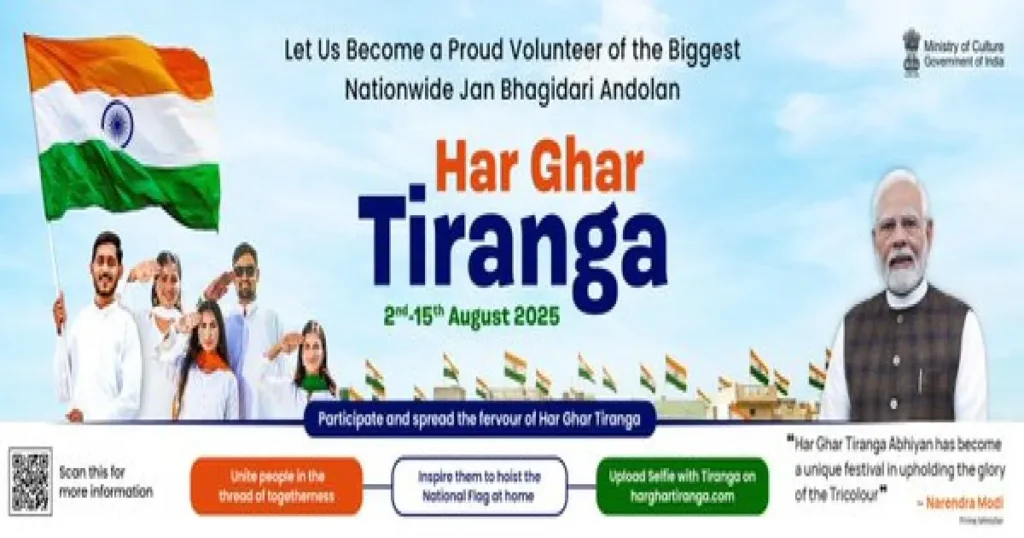Har Ghar Tiranga 2025
Har Ghar Tiranga 2025 inspired citizens nationwide to celebrate freedom and unity—bridging divides with the Tricolour, boosting civic pride, honoring artisans, and engaging young and old in democratic tradition.

Why is it in News?
On August 15, 2025, as India marked its 79th Independence Day, the “Har Ghar Tiranga 2025” campaign resonated across the nation. This nationwide initiative calls upon every citizen to hoist the Tricolour at their homes, workplaces, schools, and public spaces. The 2025 campaign saw broader participation than ever before, leveraging social media and digital platforms to spark a wave of patriotism and collective celebration.
The government’s primary aim was to foster national consciousness and reinforce the feeling of unity, particularly among the youth and in rural areas. “Har Ghar Tiranga” has evolved from a ceremonial act into a citizens’ movement reflecting India’s vibrancy, diversity, and democratic ethos.
Purpose and Significance
At its heart, the campaign strives to ignite a sense of patriotic pride and remind citizens of the struggles and sacrifices that earned India its freedom. By encouraging all Indians to display the national flag, it bridges cultural, linguistic, and regional divides—reinforcing the ideal of “unity in diversity.”
The campaign also serves as an educational tool, especially for younger generations who may be distanced from national symbols and the real meaning of independence. Through this tradition, they connect to India’s rich heritage and the values enshrined in the Constitution.
Economically, the campaign provides a boost to local artisans and small-scale manufacturers who craft the flags, supporting Atmanirbhar Bharat (self-reliant India).
Social media has been a powerful amplifier: citizens widely shared images and stories with the #HarGharTiranga hashtag, making patriotism a shared, nationwide phenomenon.
Important Information
- The Har Ghar Tiranga campaign was first launched in 2022 as part of the Azadi Ka Amrit Mahotsav.
- All flags used must comply with Bureau of Indian Standards norms and are made only of khadi, cotton, silk, or approved synthetic materials.
- The government has issued detailed guidelines for hoisting and respecting the Tricolour (Flag Code of India, 2002); provisions now allow flags to be flown at night if properly illuminated.
- The 2025 campaign utilized a dedicated website (harghartiranga.com) and app for uploading photos and distributing digital participation certificates.
- This year, special attention was given to outreach in rural and remote areas, leveraging Panchayati Raj institutions for deeper penetration.
- Schools held educational programmes to teach children about the flag’s history and significance.
- The government further relaxed flag production rules in recent years to allow polyester and machine-made flags.
Fact Table
| Aspect | Details |
|---|---|
| Campaign Name | Har Ghar Tiranga 2025 |
| Date Celebrated | August 15, 2025 (79th Independence Day) |
| First Initiated | 2022, under Azadi Ka Amrit Mahotsav |
| Key Hashtag | #HarGharTiranga |
| Official Website | harghartiranga.com |
| Flag Requirements | BIS standards: khadi, cotton, silk, polyester |
| Legal Basis | Flag Code of India, 2002 |
| Main Target Group | All Indian citizens, especially youth and rural |
Conclusion
Har Ghar Tiranga 2025 isn’t merely an annual tradition—it is a vibrant reaffirmation of India’s unity and democratic spirit. The campaign demonstrates how modern tools and technology can combine with timeless symbols to foster social integration, national pride, and awareness.
By motivating citizens to hoist the flag, India reminds itself that true patriotism is participation, not just ritual. The campaign’s inclusivity—rural and urban, young and old—ensures that national identity is a lived experience shared by all.
Going forward, such campaigns will continue to bridge generational and regional gaps, helping India celebrate its diversity and cherish its freedom.
Key Facts
- Har Ghar Tiranga started in 2022 under Azadi Ka Amrit Mahotsav
- 2025 campaign—nationwide push on August 15 (79th Independence Day)
- Aimed at all households, especially rural and youth; schools held flag education
- Flags: BIS standards, made from khadi, cotton, silk, polyester (India Post supplies)
- Key hashtag: #HarGharTiranga; site: harghartiranga.com
- Participation: selfies, digital certificates, rural outreach via PRIs
- Legal basis: Flag Code of India, 2002 (revised for new materials, illuminated flying okay)
- Empowers artisans, small manufacturers—economy gets boost
- Ongoing mass movement: national pride meets civic education
UPSC Practice Questions
- Analyze the role of national symbols in fostering unity and integrity in India, with reference to the Har Ghar Tiranga campaign.
- Evaluate the effectiveness of community-driven campaigns in building civic consciousness and patriotism.
- Discuss the use of technology in amplifying civic movements and its impact on social cohesion.
- Assess the legal and cultural importance of the national flag in strengthening democratic values in India.
